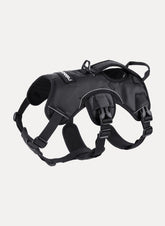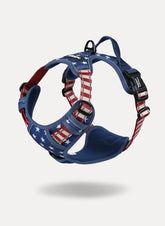Cold Weather's 3 Effects on Dogs
Pets exhibit a diverse range of attitudes towards cold weather. While some, particularly dogs, seem to enjoy the fun of playing snow during the chilly season. With its breathtaking snow-covered landscapes and twinkling holiday lights, winter offers a serene and magical charm. However, beneath this serene exterior, the cold weather poses numerous potential hazards to our beloved dogs that are less prevalent during other times of the year. This post will expose 3 common hazards to pet owners, which can help owners avoid danger in advance and identify the dog's physical condition in time.

NO.1 Hypothermia & Frostbite
It is a common belief that dogs, with their thick fur, have a stronger ability to withstand cold than humans. However, this view is not comprehensive. The fur of dogs does play an indispensable role in resisting the severe winter cold, but it cannot be ignored that the dog's resistance to cold is also affected by its breed, age, health status and the specific environment it lives in. Therefore, when playing outside, the pet owner needs to pay attention to the dog's physical condition to prevent the dog from hypothermia or frostbite.
Hypothermia warning
1. Shivering: Dogs shiver instinctively in cold environments to increase their body temperature. If your dog starts to shiver uncontrollably while outdoors, this is likely a clear sign that he is feeling cold.
2. Seeking a warm place: Dogs are very smart animals, and when they feel cold, they instinctively seek out warm places to hide. If your dog frequently tries to get close to heat sources, such as direct sunlight, by a fire, or around humans, when outdoors, this may also be a sign that he is about to suffer from hypothermia.
3. Abnormal body temperature: Although it may not be possible to directly measure a dog's body temperature in an outdoor environment, you can sense changes in its body temperature by touching its extremities, such as its ears, tail, and paws. If these parts become abnormally cold, then the dog is likely on the verge of hypothermia.

Frostbite treatment
Long-term outdoor activities may cause frostbite on some sensitive parts of the dog. The dog’s frostbite wounds should be checked and treated promptly after returning home.
1. Emergency treatment: If you find your dog is frostbitten, you should immediately move it to a warm, dry environment to avoid further cold. At the same time, wrap the dog's body with a blanket or towel to maintain body temperature.
2. Warm water reheating: Prepare warm water of about 37°C (be careful not to use overheated water), soak the injured part in warm water or wet it with a towel, and gently pat it dry with a towel after warming up.
3. Medical treatment: For severe frostbite, take the dog to the doctor in time. The veterinarian will conduct a professional examination, assess the degree of frostbite, and give appropriate treatment.
Tips: When encountering extremely cold weather, rabbitgoo sincerely recommends that you let your dog enjoy the fun of toys and sleep peacefully in its warm dog bed. If your dog is lively and active by nature, then spending happy time with it in the backyard or in front of the door is a good choice, but please be sure to control the activity time to no more than 20 minutes. In order to ensure that it will not run away and get lost due to excitement during outdoor activities, please remember to put on a comfortable dog harness for it.
NO.2 Physical Injury
Any activity carries with it the risk of injury, but dogs are particularly vulnerable to injury and illness during the winter.
Ligament strain
Their four legs and a lower center of gravity offer significant protection, making dogs less prone to slipping on ice and suffering from bone fractures or head injuries as humans might. However, they can glide on icy surfaces by their paws, which may lead to bruising or ligament tearing if they glide too fast. They face a risk similar to humans with cranial cruciate ligament ruptures, which can occur when they slip during playful activities on ice and snow.
Way to control: Use a dog harness and leash to control your dog if he is too fast.
Ice cuts
Additionally, icy and crusty snow can be as sharp as a knife, cutting into the dog's paws and damaging their claws. Such injuries often necessitate stitching and can take several weeks to heal, requiring proper bandaging and sufficient rest for recovery. Therefore, it's crucial to exercise caution near frozen ponds.
Way to avoid: put dog winter boots on your dog to avoid ice cuts.
Joint pain
Individuals suffering from arthritis have frequently reported that cold weather intensifies their discomfort. Despite a lack of clear understanding regarding the exact cause, this phenomenon is widely documented. Some individuals even claim to be able to foresee changes in the weather based on the increased pain in their joints. Similarly, if your dogs or cats are experiencing similar health issues, they may also find cold weather particularly challenging.
Way to relieve pain: Keep the room warm and let your dog rest comfortably in his or her own dog bed.
NO.3 Chemicals poisoning
Heavy snowfall can pose significant inconveniences to traffic. Whether it involves clearing snow from doorsteps or removing snow from roadways, the utilization of snow-melting products can greatly alleviate the burden of manual labor. Nevertheless, it is important to know that these snow melting products have some potential risks to dogs. They typically contain chemicals that may impact the health of our beloved animals.
Ingredients and toxicity
Most commercial snow melting products contain chemicals such as potassium chloride, magnesium chloride, calcium carbonate, calcium chloride, and calcium magnesium acetate. These compounds may cause irritation or even chemical burns to the dog's paw pads.
It is particularly worth noting that ethylene glycol, as the main component of antifreeze, is also present in some snow melting products, but it is highly toxic to dogs, and even ingesting a small amount may cause renal failure.

Precautions
1. Avoid harmful products: Try to choose pet-friendly snowsnow melting products. When purchasing them, read the product instructions carefully to ensure that they are safe for dogs. And after use, place them in a place where dogs cannot touch them.
2. Protect your dog's paw pads: When going out, put dog winter boots on your dog to reduce direct contact between its paws and snow-melting products. Or use pet-specific protective wax or vaseline to reduce the risk of chemical irritation and burns.
3. Clean in time: After returning from going out, clean their paws with wet wipes ,or warm water and pet-specific detergent in time.
4. Pay attention to your dog's health: Observe your dog's behavior and health closely. If you find any abnormal symptoms in your dog, such as vomiting, diarrhea, skin redness or pain, please take them to the doctor immediately.
Final Words
In conclusion, winter poses unique risks to our dogs, including chemical poisoning from snow-melting products, hypothermia, frostbite, and physical injuries such as ligament strains, ice cuts, and joint pain exacerbated by cold weather. To ensure their safety and well-being, pet owners should take necessary precautions and keep in mind the dog winter care tips so that we can help our dogs enjoy a safe and happy winter.







